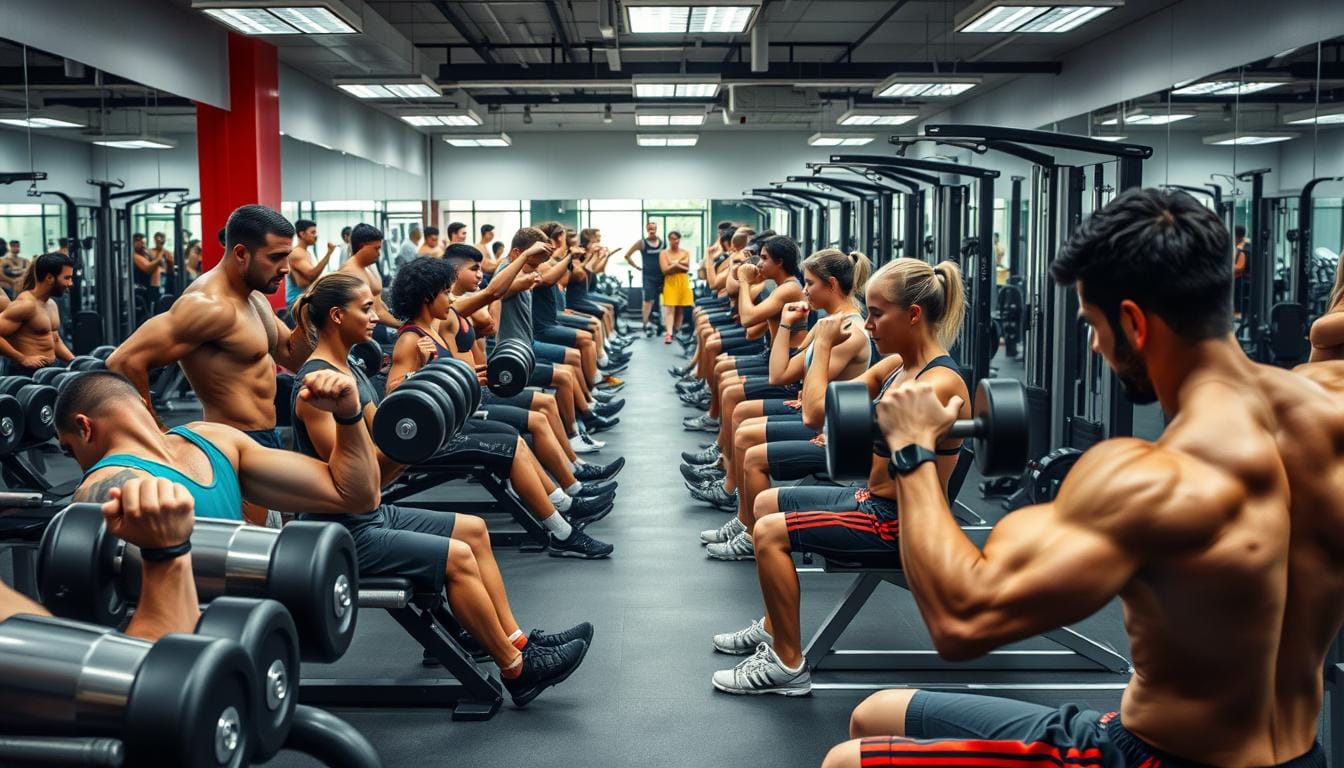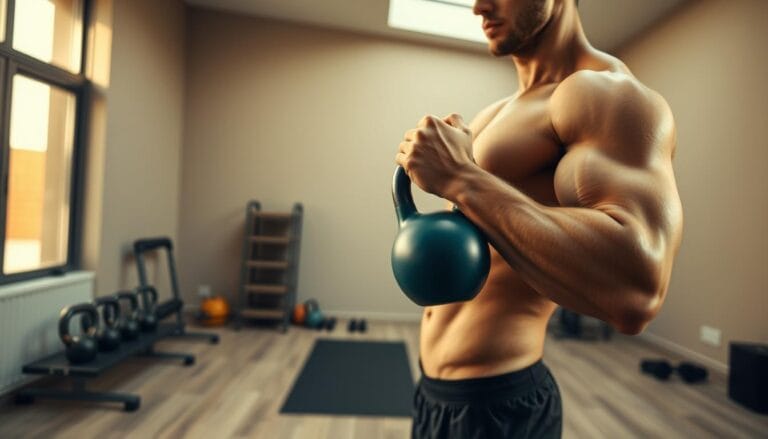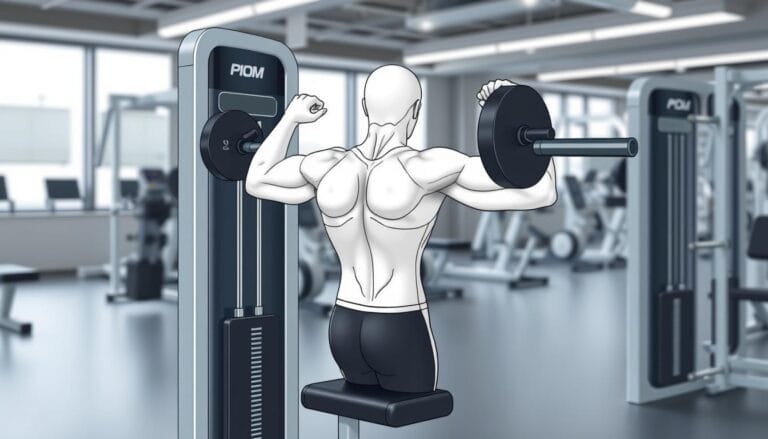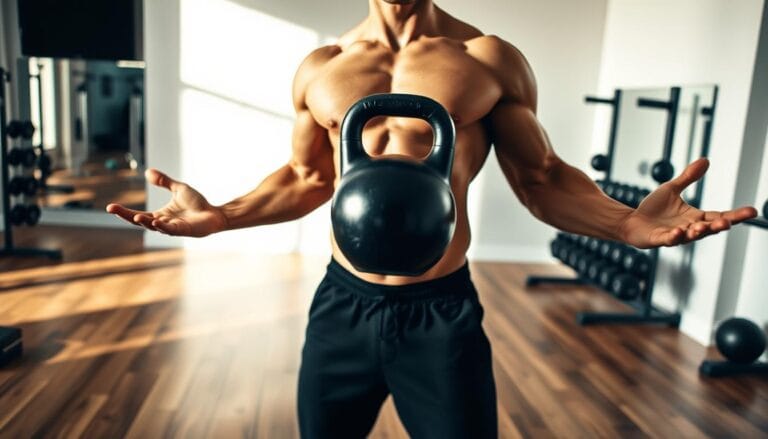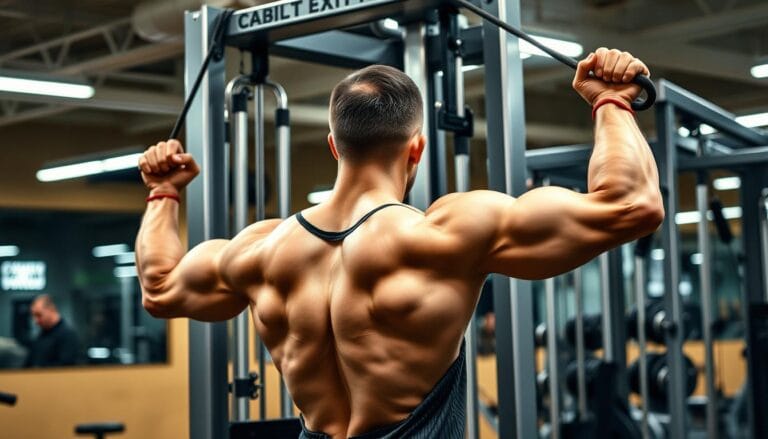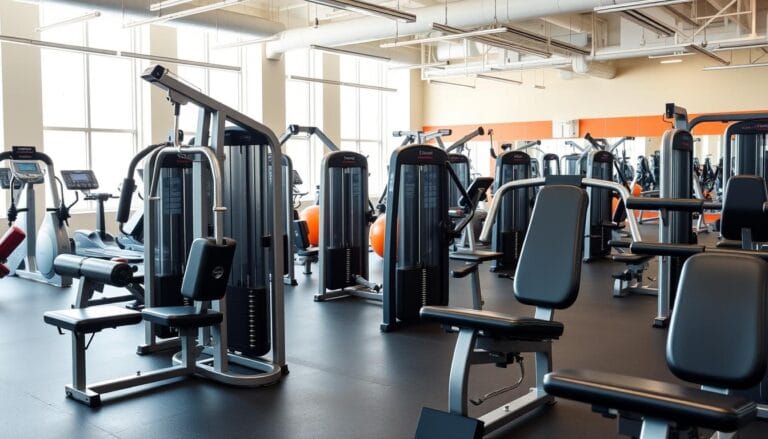“Ultimate Chest and Shoulder Workout Routine for Upper Body Strength”
I remember standing in the gym, feeling frustrated with my lack of upper body strength. I wondered if I could ever build the muscular physique I dreamed about. That moment sparked my passion for a targeted chest and shoulder workout.
Your upper body strength isn’t just about looking good. It’s about feeling powerful, confident, and capable. A strategic chest and shoulder workout can unlock your body’s true potential. It helps you build muscle, improve functional strength, and boost overall athletic performance.
This comprehensive guide will walk you through an intelligent approach to upper body strength training. Whether you’re a beginner or an experienced lifter, we’ll break down everything you need to know. We’ll show you how to develop a powerful chest and shoulder routine that delivers real results.
Training your chest and shoulders together offers unique advantages. By targeting these muscle groups strategically, you can maximize muscle growth. You can also improve pressing strength and create a balanced, symmetrical upper body. The key is understanding how to structure your workouts for optimal performance and recovery.
Throughout this article, you’ll discover proven techniques to transform your upper body strength workout. We’ll cover essential exercises, training frequency, set and rep ranges, and critical strategies. These will help you progress safely and effectively.
Get ready to unlock your body’s true potential with this ultimate chest and shoulder workout approach. Your strength journey starts now.
Table of Contents
Understanding Upper Body Anatomy and Muscle Function
To get the most out of your arm and chest workout, you need to know about muscle anatomy. Your upper body muscles work together in a complex system. This system is what makes movement possible. Learning how pectoral and deltoid muscles work together can really boost your strength training.
Upper body muscles aren’t just separate groups. They form a network that powers your movements. Let’s look at the main muscle groups that affect your strength training.
Pectoralis Major and Minor: The Chest Powerhouse
Your chest muscles are key for pushing movements. The pectoralis major has two heads. It helps with:
- Horizontal arm adduction
- Internal arm rotation
- Arm flexion
The pectoralis minor, under the major, helps keep your shoulders stable. It also aids in scapular movement. Having strong pecs is important for:
- Lifting objects
- Pushing movements
- Athletic performance
Deltoid Muscle Groups: Shoulder Mechanics
Your shoulders have three deltoid regions, each with its own role in workouts:
- Anterior Deltoid: Supports front arm lifting
- Lateral Deltoid: Enables side arm raises
- Posterior Deltoid: Facilitates rear arm movements
Muscle Synergy in Upper Body Training
It’s important to know how chest and shoulder muscles work together. They team up during complex movements. This creates a strong, integrated strength system.
“Muscles don’t work in isolation – they’re a symphony of coordinated movement.” – Strength Training Expert
By understanding these muscle interactions, you can create more focused workouts. These workouts will better engage and grow your muscles.
Benefits of Combined Chest and Shoulder Training
Creating a chest and shoulder routine can change how you work out your upper body. By combining chest and shoulder exercises, you get many benefits. These can help you get fit faster.
This way of training makes your workouts more efficient. Studies show that working on both muscle groups at once can:
- Make muscles work better
- Help you manage your time during workouts
- Let you train more often
- Improve your upper body overall
Dumbbells make your muscles work harder by engaging more fibers. Chest and shoulder muscles work together. This means exercises like bench presses work many muscles at once.
“Training chest and shoulders together creates a synergistic effect that maximizes your workout potential.”
When you plan your workouts well, you can see big gains in strength. Experts suggest doing supersets with 6-12 reps. They recommend focusing on exercises that work many muscles at once.
Try alternating between chest and shoulder exercises. This keeps your muscles working hard without getting too tired. It makes sure you’re working all the right muscles without overdoing it.
With a good chest and shoulder routine, you’ll get stronger muscles. You’ll also improve your overall fitness and how your body looks.
Essential Equipment for Chest and Shoulder Workout
Choosing the right gear is key for a good chest workout. It helps in building muscle and improving fitness. The tools you use can greatly affect your results.
There are many tools for working out, each with its own benefits. Knowing what’s out there helps you plan your workouts better.
Free Weights: The Foundation of Strength Training
Free weights are top for building muscle. Dumbbells are great for chest presses because they let you move naturally. This also works your stabilizer muscles.
- Barbells for compound movements
- Dumbbells for unilateral training
- Adjustable weight sets for home workouts
Machine-Based Equipment Options
Chest press machines help with structured movements and steady resistance. They’re good for beginners and those healing from injuries.
- Cable machines for continuous muscle tension
- Plate-loaded chest press equipment
- Pneumatic resistance machines
Resistance Bands and Alternative Tools
Resistance bands are a light, easy-to-carry option for chest workouts. They provide constant tension and fit into any fitness plan.
“Resistance bands offer increased muscle stimulation with decreased injury risk compared to traditional weights.” – Fitness Research Institute
- Lightweight and portable
- Versatile for multiple exercise variations
- Cost-effective training option
Each piece of equipment has its own benefits for chest and shoulder exercises. Pick what fits your goals, experience, and what you have available.
Chest and Shoulder Workout Fundamentals
To build a strong upper body, you need to know the basics of chest and shoulder training. Success comes from mastering key principles that help muscles grow and avoid injuries.
Good form is the first step to a great workout. Without it, you might not work your muscles right and could get hurt. Here are the must-know basics:
- Keep your body straight during exercises
- Move weights smoothly through the full range of motion
- Breathe the same way during each rep
- Begin with lighter weights to get your form right
Progressive overload is another key idea. It means making your workouts harder by changing things like:
- Adding more weight
- Doing more reps
- Working out more often
- Trying harder exercises
“Muscle growth happens outside your comfort zone” – Professional Strength Training Coaches
It’s also important to balance your workout. This means focusing on different muscles to avoid imbalances and injuries. Your chest and shoulder exercises should work all the muscles evenly.
| Training Aspect | Recommended Approach |
|---|---|
| Weekly Frequency | 2-3 times per muscle group |
| Set Range | 3-4 sets per exercise |
| Repetition Range | 8-12 repetitions |
| Rest Between Sets | 60-90 seconds |
Knowing these basics turns your chest and shoulder workout into a smart plan for building muscle.
Key Compound Exercises for Maximum Results
Compound exercises are the heart of a good arm and chest workout. They work many muscles at once, leading to better strength and muscle growth. This means you get more out of your workouts for your chest and shoulders.
Studies show compound lifts are great for building muscle. A study in the Journal of Strength & Conditioning Research found they help with muscle growth. This is because they create tension and stress in the muscles.
Bench Press Variations
The bench press is key for working your chest. There are different ways to do it, each focusing on different parts of your chest:
- Flat Bench Press: Works the whole chest
- Incline Bench Press: Builds the upper chest
- Decline Bench Press: Targets the lower chest
Military Press Techniques
Military presses are important for strong shoulders. They work many muscles, like your deltoids, triceps, and upper chest.
| Press Type | Primary Muscles Targeted | Difficulty Level |
|---|---|---|
| Standing Overhead Press | Deltoids, Triceps | Intermediate |
| Seated Dumbbell Press | Shoulders, Upper Chest | Beginner |
Push-Up Progressions
Push-ups are great for all fitness levels. You can make them harder to build strength and muscle:
- Standard Push-Ups
- Elevated Push-Ups
- Weighted Push-Ups
- Plyometric Push-Ups
“Mastering compound exercises is the key to unlocking your body’s true strength potential.” – Fitness Expert
Remember, proper form is crucial in preventing injuries and maximizing muscle engagement during these compound exercises.
Isolation Exercises for Muscle Definition
Your chest and shoulder routine isn’t complete without targeted isolation exercises. These precise movements help shape specific muscles. They create definition and fix muscle imbalances. Shoulder raises and rotator cuff exercises are key for a balanced upper body.
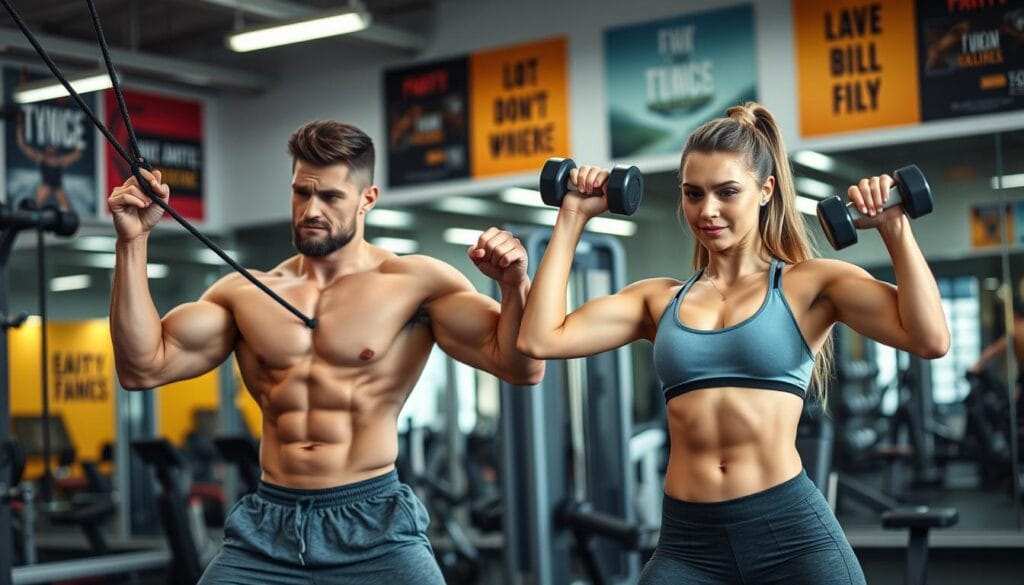
Isolation exercises focus on one muscle group with little joint movement. They offer special benefits for muscle growth:
- Enhance muscle definition
- Address specific muscle weaknesses
- Improve mind-muscle connection
- Support injury rehabilitation
Key isolation exercises for your chest and shoulder routine include:
- Lateral Raises: Target shoulder deltoids
- Cable Flyes: Develop chest muscle definition
- Front Raises: Strengthen anterior deltoids
- Rotator Cuff Exercises: Improve shoulder stability
“Precision in movement creates perfection in muscle development.” – Fitness Training Principle
When doing these exercises, focus on proper form and controlled movements. Start with lighter weights to get the technique right. Then, increase the weight as you get better. Aim for 3 sets of 10-12 reps for best muscle growth.
Professional bodybuilders suggest doing isolation exercises after compound movements. This way, you get full muscle development without risking injury.
Progressive Overload and Training Variables
Mastering your chest and shoulder workout means understanding progressive overload. This key strategy is vital for building upper body strength and avoiding plateaus. By gradually pushing your muscles, you ensure ongoing growth and reach your fitness goals.
Setting the Right Volume
Volume is key in a good upper body strength training plan. Your strategy should be well-planned and step-by-step:
- Begin with 5 sets of 5 reps
- Slowly add sets from 5 to 6, then 7
- Keep the weight the same when you first increase volume
Rest Periods and Recovery
Recovery is crucial for muscle growth and injury prevention. Use smart rest periods:
- Take 3-minute breaks between intense chest and shoulder exercises
- Give 48-72 hours off between working the same muscles
- Pay attention to how your body feels
Weight Selection Guidelines
Picking the right weights for your workout is about careful progress:
- Up the weight by 2-3% each week
- For upper body, aim for 5-pound increases
- Keep proper form while getting stronger
“Progressive overload is not about lifting the heaviest weights, but about smart, consistent challenge.”
Keep a close eye on your workouts. Your upper body strength grows with careful, planned effort—not random tries.
Common Training Mistakes to Avoid
Getting a good upper body workout is more than just lifting weights. Many women make common mistakes that can stop their fitness progress. These mistakes can even cause injuries.
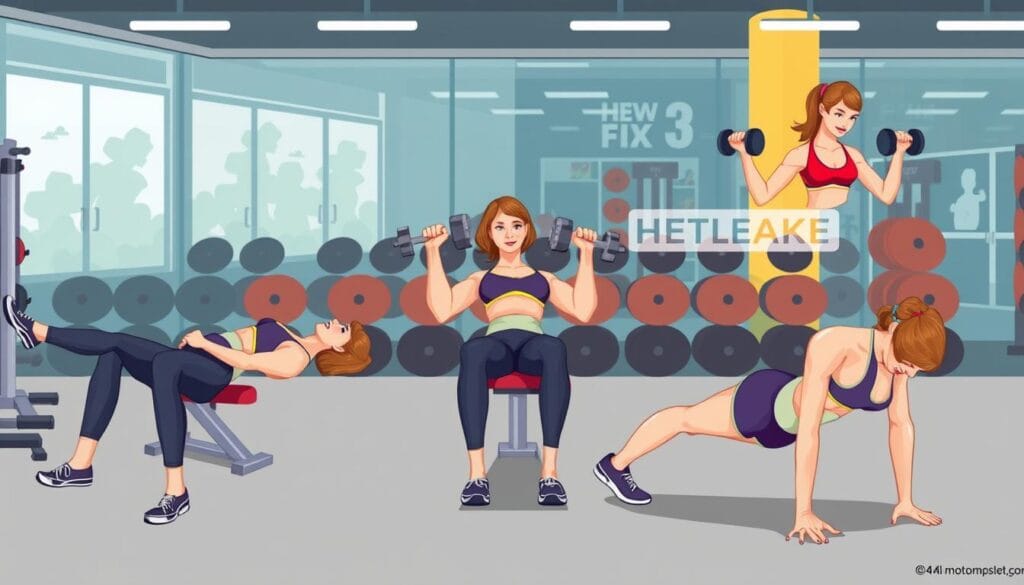
When doing a chest workout, knowing the mistakes is key to getting the best results. Let’s look at the most important errors to avoid:
- Neglecting Proper Form: Sacrificing technique for heavier weights dramatically increases injury risk
- Overtraining Muscle Groups: Insufficient recovery time prevents muscle growth and repair
- Unbalanced Exercise Selection: Focusing exclusively on one muscle area creates structural imbalances
Your upper body workout should focus on smart training. Here are important things to think about for better chest and shoulder development:
| Mistake | Potential Consequence | Recommended Solution |
|---|---|---|
| Limited Range of Motion | Reduced Muscle Engagement | Complete Full Movement Patterns |
| Incorrect Rep Ranges | Stunted Muscle Growth | Target 8-12 Repetitions |
| Machine Dependency | Reduced Stabilizer Muscle Development | Incorporate Free Weight Exercises |
“The quality of your workout matters more than the quantity of weight lifted.”
Focus on how you do the exercises. Controlled movements with the right muscle use will give better results than just trying to lift more.
Remember, a good chest workout for women needs patience, regular effort, and smart training. By avoiding these common mistakes, you’ll be on the right path to strong upper body muscles.
Building Your Workout Schedule
Creating a good chest and shoulder routine needs careful planning. It’s important to balance how hard you work out, rest, and which muscles you focus on. The Physical Activity Guidelines suggest doing strength training at least twice a week for the best health.
When making your chest and shoulder workout plan, keep these points in mind:
- Training frequency: 3-4 days per week
- Rest periods: 48 hours between muscle group workouts
- Progressive overload strategy
- Balanced muscle group development
A good weekly schedule could be:
- Monday: Chest and Shoulder Focus
- Wednesday: Lower Body and Core
- Friday: Back and Arms
- Weekend: Active Recovery or Rest
“Consistency is key in developing upper body strength and muscle definition.”
To get the best results from your chest and shoulder routine, follow these tips:
- Do 3 sets of 8-12 reps for each exercise
- Begin with weights you can handle easily
- Slowly add more weight as you get stronger
- Rest for 90 seconds between sets
Your workout should include big exercises like bench press and overhead press. Add some isolation exercises too. Keep track of your progress each week. Try to lift heavier weights or do more reps to keep growing your muscles.
Conclusion
Your chest and shoulder workout is more than lifting weights. It’s a way to boost your strength and body shape. By using the tips from this guide, you’ll learn how to train your upper body well.
Being consistent is crucial for success in upper body workouts. People have seen big changes, like gaining 20 pounds or hitting bench press goals of 315 pounds. Stick to a plan with 4+ weekly sessions and varied exercises to see real results.
Don’t just work hard; work smart. Include exercises for other muscles, stick to 8-12 reps, and rest well. Building a strong upper body takes time, patience, and adjusting your workout as you get stronger.
Enjoy the journey, track your progress, and stay motivated. With hard work in your upper body workout, you’ll not only look great but also feel confident and ready for any fitness challenge.

